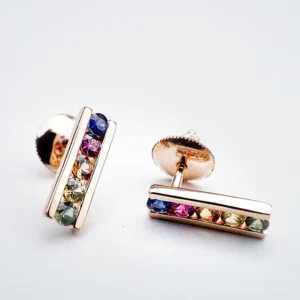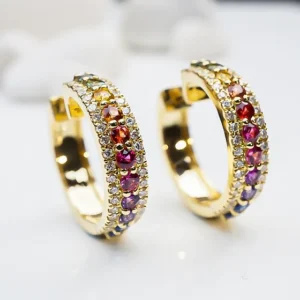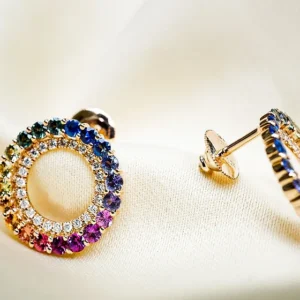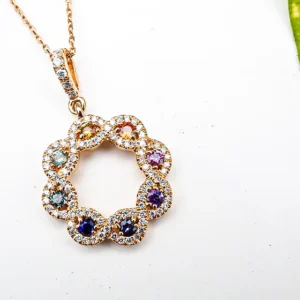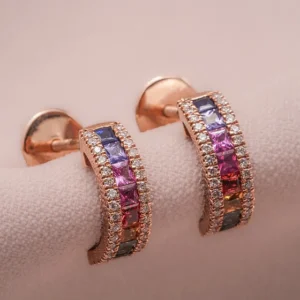Exploring Diamond Cut: The Ultimate Guide to Unveiling Brilliance and Elegance
When it comes to diamonds, their captivating brilliance is the result of a harmonious interplay of elements. Among these, the diamond cut takes center stage. Beyond mere shape, it involves angles, proportions, and craftsmanship that reveal the gem’s inner radiance. This guide delves into the world of diamond cuts, exploring their significance, diverse types, and impact on value and appearance.
Table of Contents
Diamonds’ mesmerizing sparkle is rooted in the interaction of factors, with cut reigning as the conductor of brilliance. It’s not just geometry; it’s a fusion of angles and proportions that sculpt light into a captivating dance.
The diamond cut goes beyond aesthetics. Craftsmanship transforms potential into a symphony of angles and facets that refract light into a mesmerizing display.
This guide is your gateway to the universe of diamond cuts. We unravel their importance and explore types like the timeless round brilliant, modern princess cut, and the elegance of the emerald cut.
Cut quality defines a diamond’s sparkle. Mastery in shaping facets results in brilliance, while a lackluster cut conceals beauty. Unveiling cut quality is a journey to grasp the essence of diamonds.
From round brilliance to the geometric princess cut, each diamond cut has a story. The emerald cut whispers elegance, while the marquise exudes regal charm. The heart cut symbolizes love, and the Asscher cut brings vintage allure.
As we delve, you’ll unlock diamond mysteries, discover intricacies, and understand the transformation from raw gems to resplendent jewels. With each insight, you’ll appreciate diamonds anew. Welcome to a realm where science meets art, where facets and angles compose the enchanting symphony—diamond cut.
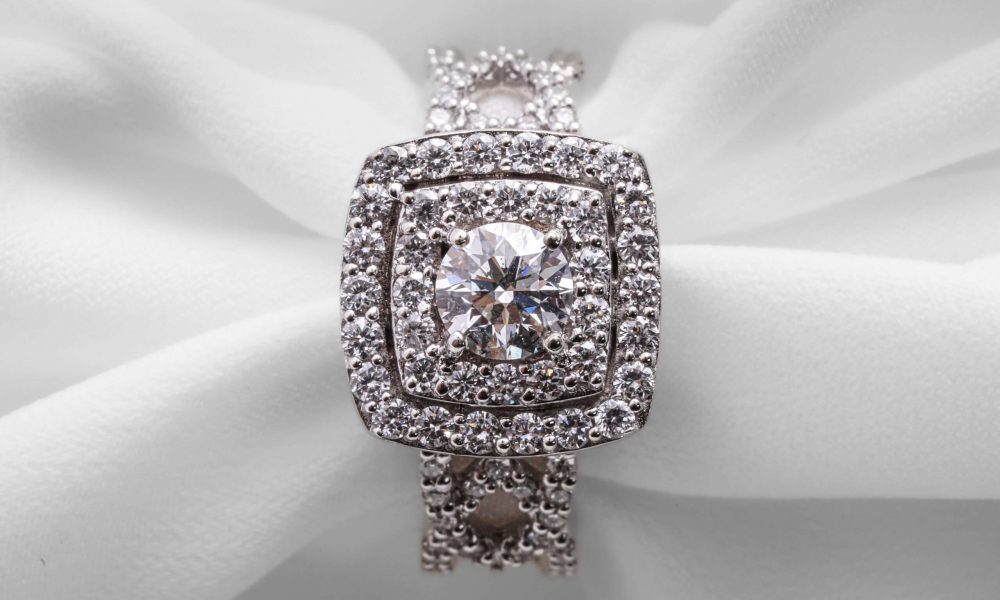
A Perfect Diamond Cut Ring
Understanding Diamond Cut
Diamond cut is a crucial factor that significantly impacts a diamond’s visual appeal, light performance, and overall value. The term “cut” encompasses not only the diamond’s shape (e.g., round, princess, emerald) but also how well the diamond’s facets interact with light to create that captivating sparkle.
The quality of a diamond’s cut directly influences its ability to reflect and refract light, resulting in its brilliance, fire, and scintillation.
Historical Evolution of Diamond Cutting
The journey of diamond cutting dates back to the 14th century when diamonds were first adorned as uncut, rough stones. As the centuries progressed, skilled artisans in various regions began experimenting with different facets and shapes to enhance their beauty.
It was only in the mid-20th century that breakthroughs in optics and technology paved the way for modern diamond cutting techniques that optimize brilliance and light dispersion.
Diamond Cut Grades and Proportions
Leading gemological laboratories assess diamond cuts based on various criteria, including proportions, symmetry, and polish. The GIA (Gemological Institute of America) employs a grading scale ranging from Excellent to Poor, helping consumers understand the quality of a diamond’s cut.
Each grade corresponds to the diamond’s ability to reflect light optimally and emit the desired brilliance.
Key Factors of Diamond Cut
A diamond’s cut is composed of several crucial components that determine its overall appearance and appeal. The crown, table, girdle, pavilion, and culet collectively shape the diamond’s proportions, determining how light interacts with the stone.
These facets are meticulously cut to specific angles and proportions, allowing light to enter, reflect, and refract, resulting in the mesmerizing sparkle diamonds are famed for.
Proportions and Angles
The proportions and angles of a diamond’s facets determine how light enters the stone and how it exits as brilliance. When the proportions are ideal, light bounces around within the diamond, creating a stunning play of colors and radiance. Common measurements include table percentage, depth percentage, and crown and pavilion angles.
Symmetry
Symmetry refers to the alignment and balance of a diamond’s facets. Precise symmetry ensures that light is evenly distributed across the diamond’s surface, enhancing its overall sparkle. Imperfections in symmetry can lead to dark areas and reduced brilliance.
Polish
A diamond’s polish grade signifies the quality of its surface finish. A higher polish grade indicates fewer blemishes and smoother facets, allowing light to pass through without hindrance. Proper polishing contributes to maximum light reflection.
Cut Grades
Different gemological laboratories use various grading systems to evaluate a diamond’s cut quality. The GIA (Gemological Institute of America) uses a scale ranging from Excellent to Poor, while other labs may employ different terms. It’s important to understand the grading scale of the laboratory assessing the diamond.
Impact on Diamond Appearance
A diamond’s cut profoundly influences its brilliance, which refers to the internal and external light reflections that create the stone’s dazzling sparkle. When light enters a well-cut diamond, it undergoes total internal reflection within the diamond’s facets, causing the light to dance and reflect back to the observer’s eye.
This captivating play of light is what makes diamonds stand out and captures our hearts. The quality of a diamond’s cut greatly influences its appearance and how it interacts with light. A well-cut diamond exhibits the following characteristics:
Brilliance
A diamond with an excellent cut exhibits maximum brilliance, which is the brightness created by the white light reflecting off the diamond’s facets. Properly proportioned facets ensure that light is refracted optimally, resulting in intense sparkle.
Fire
Fire refers to the flashes of color that a diamond displays as it moves. When light enters a diamond and is broken down into its spectral colors, it creates a dazzling array of hues. A well-cut diamond disperses light beautifully, showcasing its spectral fire.
Scintillation
Scintillation is the dynamic play of light and dark areas as a diamond is moved. It is a captivating visual effect caused by the interaction between the diamond’s facets and the light source. A well-cut diamond exhibits lively scintillation that adds to its allure.
Size Perception
A well-cut diamond can appear larger than its actual carat weight due to its ability to reflect light and maximize its visual impact. This means that even a slightly smaller diamond with an exceptional cut can be more visually striking than a larger diamond with a lower cut quality.
Types of Diamond Cuts
Each of these Diamond cuts is a testament to the creativity and precision of diamond artisans, shaping stones into resplendent works of art. While their individual characteristics vary, they all share a common thread—an ability to capture hearts and light in their own extraordinary ways.
As you explore these diverse cuts, you’ll uncover a world where every angle and facet contributes to a symphony of beauty and brilliance:
Round Brilliant Cut Diamond
The round brilliant cut stands as a timeless masterpiece, a culmination of centuries of refinement. With its 58 facets meticulously arranged for maximum sparkle, it remains the pinnacle of diamond brilliance.
Princess Cut Diamond
In stark contrast, the princess cut boasts a modern geometric allure. Its square or rectangular shape marries traditional elegance with contemporary flair, making it a favorite for those seeking the best of both worlds.
Emerald Cut Diamond
Exhibiting understated sophistication, the emerald cut features a rectangular shape with stepped facets. Its transparent allure emphasizes clarity, rendering it a popular choice for those who appreciate refined elegance.
Cushion Cut Diamond
Resembling a plush pillow, the cushion cut exudes charm with its rounded corners. Its larger facets strike a delicate balance between brilliance and fire, creating a unique blend of visual splendor.
Marquise Cut Diamond
Elongated and regally tapered at the ends, the marquise cut captures attention with its distinctive boat-like silhouette. This cut maximizes the illusion of size while exuding a timeless elegance.
Radiant Cut Diamond
A radiant cut marries the allure of a rectangular or square shape with the dazzling brilliance of brilliant cuts. With cropped corners and a multitude of facets, it showcases a unique blend of fire and scintillation, making it a true embodiment of radiance.
Oval Cut Diamond
The oval cut offers a twist on the classic round shape, elongating it for a more elegant and elongated appearance. With its symmetrical appeal, it creates the illusion of length while retaining the brilliance that captivates.
Pear Cut Diamond
Combining the grace of a teardrop with the fire of a brilliant cut, the pear cut is a fusion of artistic innovation. Its unique silhouette balances elegance and sparkle, making it a symbol of sophistication and individuality.
Heart Cut Diamond
The heart cut, as its name implies, is the ultimate symbol of love and devotion. This intricate cut requires masterful skill to create the distinctive heart shape, making it a popular choice for sentimental occasions.
Asscher Cut Diamond
Inspired by the Art Deco era, the Asscher cut showcases a square shape with deeply cut step facets. This cut’s unique play of light creates a mesmerizing hall-of-mirrors effect, exuding vintage charm with a modern twist.
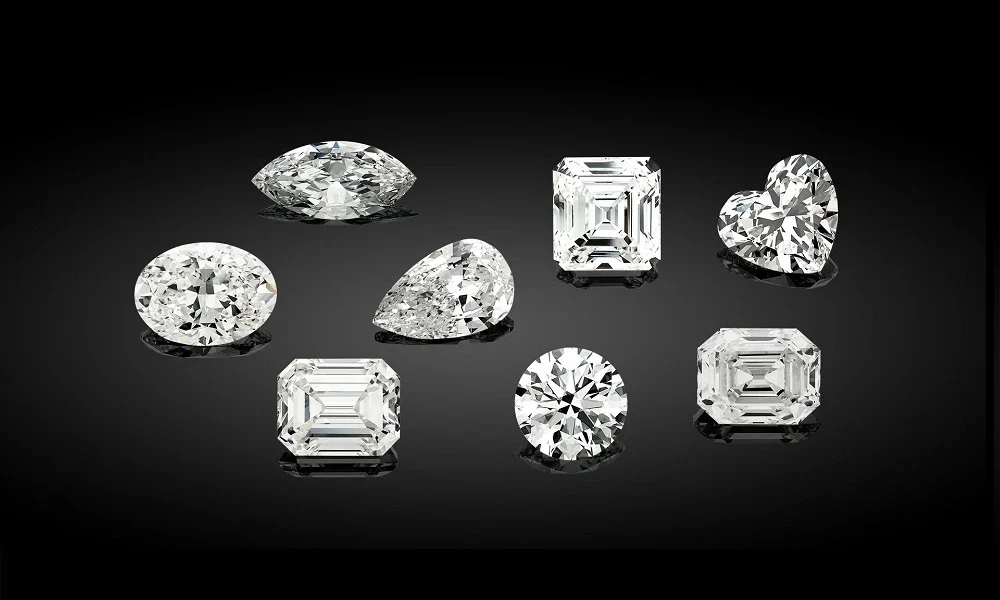
A Symphony of Diamond Shapes
Modern Innovations in Diamond Cutting
Advancements in technology and diamond cutting techniques have revolutionized the industry. Laser cutting, computer-aided design (CAD), and precise optical measurements have enabled artisans to create cuts with unprecedented accuracy and symmetry. These innovations ensure that every facet is precisely aligned to optimize light performance.
Each diamond’s journey from rough crystal to sparkling gem is a testament to human artistry and skill. The diamond cutting process involves countless hours of meticulous craftsmanship, guided by both technical precision and artistic intuition.
From the initial planning stages to the final polish, expert diamond cutters harness their knowledge and expertise to unveil a diamond’s maximum potential. The cut not only shapes the gem but also breathes life into its brilliance, fire, and scintillation – attributes that have captivated hearts for generations.
The Diamond Cutting Process
Crafting a diamond involves intricate skill and precision. The cutting process consists of several stages:
Planning: Skilled artisans plan the diamond cut to optimize its potential for brilliance. This involves determining the number, size, and angles of facets.
Cleaving or Sawing: Diamonds are typically cleaved or sawed from rough crystals. This initial step requires precision to create a starting point for the subsequent shaping.
Shaping: The diamond is then shaped using a rotating wheel coated with diamond dust. This stage establishes the gem’s basic form and facets.
Bruting: Bruting involves shaping the diamond’s edges to achieve the desired round or square shape. This stage contributes to the overall symmetry of the stone.
Faceting: Master craftsmen create the facets on the diamond’s surface, each carefully calculated to optimize light reflection and refraction.
Polishing: The final facets are meticulously polished to a mirror-like finish, enhancing the diamond’s brilliance and overall aesthetics.

Diamond Shaping
The Diamond Cut's Impact on Value
A diamond’s cut significantly influences its value. Diamonds with superior cuts command higher prices due to their exceptional visual appeal and ability to maximize light performance. When a diamond is cut to ideal proportions and angles, it unlocks its full potential for brilliance, fire, and scintillation.
Therefore, even a lower-carat diamond with an outstanding cut can surpass the beauty of a larger diamond with an inferior cut.
Investing in a well-cut diamond not only ensures a breathtaking visual experience but also holds its value over time. A high-quality cut enhances a diamond’s overall desirability and resale potential, making it a wise investment for both emotional and financial reasons.
Choosing the Perfect Diamond Cut
The 4 Cs and Diamond Cut
When evaluating diamond quality, the “4 Cs” – cut, clarity, color, and carat weight – play a significant role. Among these, cut is often considered the most crucial factor, as it directly impacts a diamond’s overall beauty and visual appeal.
A well-cut diamond can enhance the gem’s color and clarity, making it appear more vibrant and dazzling. Conversely, a poorly cut diamond may not reflect light optimally, diminishing its potential despite superior color and clarity grades.
Tips for Evaluating Diamond Cut
GIA Cut Grading: The Gemological Institute of America (GIA) assigns cut grades to diamonds, ranging from “Excellent” to “Poor.” Opt for a diamond with an “Excellent” or “Very Good” cut grade to ensure optimal light performance.
Proportions: Pay attention to the diamond’s proportions, including table percentage, depth percentage, and crown and pavilion angles. Well-balanced proportions contribute to superior brilliance.
Visual Assessment: Examine the diamond under different lighting conditions to assess its brilliance, fire, and scintillation. A high-quality cut should showcase consistent sparkle across various environments.
Certification: Purchase diamonds from reputable sources that provide certification from renowned gemological laboratories. A certified diamond ensures accurate information about its cut and other essential characteristics.
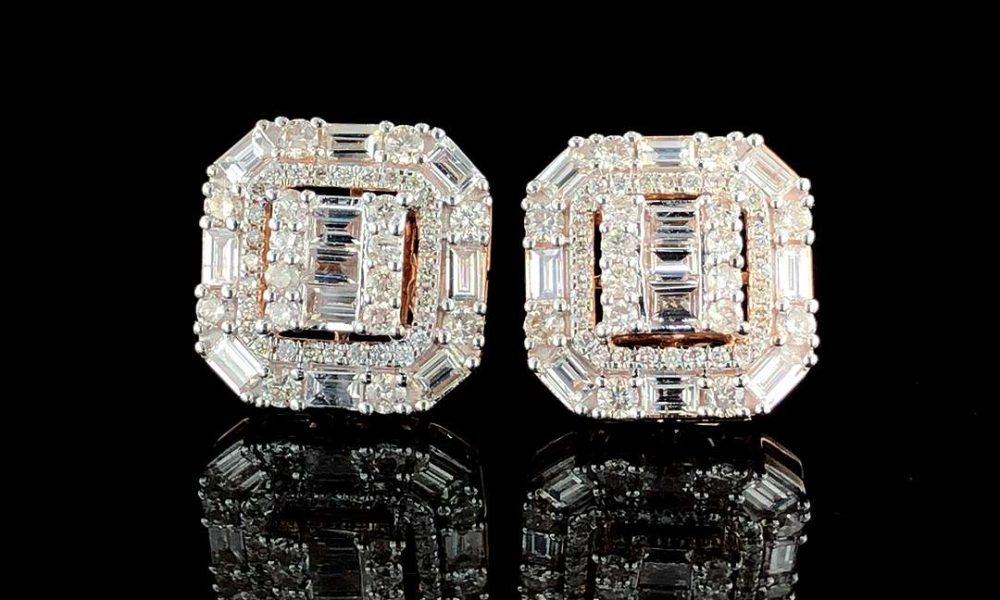
Exquisite Diamond Earrings
Caring for Diamond Cuts
Maintaining the brilliance of your diamond cut requires proper care. Regular cleaning and professional inspections will preserve its sparkle. Avoid exposing your diamond to harsh chemicals, as they can dull its appearance. When not being worn, store your diamond jewelry separately to prevent scratches.
Final Thoughts
Beyond its physical form, the diamond cut embodies a true work of artistry. It orchestrates the diamond’s capacity to capture and manipulate light, crafting an enchanting spectacle of brilliance, fire, and scintillation. Delving into the complexities of diamond cut equips you with the knowledge to make thoughtful decisions when choosing your ideal gem.
Whether drawn to the ageless charm of the round brilliant or captivated by the modern allure of the princess cut, a precisely cut diamond promises an enduring symbol of love and beauty that will radiate through generations. In this exploration of diamond cuts, we have unveiled the intricate dance of light and facets that define a diamond’s allure.
With an understanding of the significance of diamond cut, the historical journey that has led us here, and the factors that shape a diamond’s brilliance, you are now equipped to embark on your own journey of selecting the perfect gem—one that will radiate your unique elegance and style for generations to come.
FAQs About Diamond Cut
Feel free to explore these questions to gain a deeper understanding of diamond cuts and make informed decisions when selecting the perfect diamond for your needs and desires.
The diamond cut is essential as it influences a diamond's brilliance, fire, and overall visual appeal. A well-cut diamond reflects and refracts light optimally, resulting in breathtaking sparkle.
A diamond's cut significantly impacts its value. A superior cut enhances the stone's beauty and light performance, making it more desirable and valuable, even if it has a smaller carat weight.
Key factors include proportions, angles, symmetry, and polish. These elements determine how well a diamond interacts with light and how brilliant it appears.
Absolutely. Diamond cuts vary widely, from the classic round brilliant and contemporary princess cut to the elegant emerald cut and the regal marquise cut. Each type has its unique characteristics and appeal.
Choosing a diamond cut depends on personal preference and style. Consider factors like brilliance, shape, and individual taste. It's essential to balance cut quality with other aspects like color, clarity, and carat weight.
Diamond cut directly influences how light interacts within the stone. A well-cut diamond maximizes internal reflection, creating the sparkle and brilliance that captures the eye.
A shallow cut allows more light to escape through the bottom, creating a larger appearance. A deep cut retains light, emphasizing fire and color. The choice depends on personal preference and the desired visual effects.
Yes, a poorly cut diamond may appear dull and lackluster. Cut impacts a diamond's visual appeal and resale value. Investing in a well-cut diamond ensures both beauty and value retention.
Evaluate the diamond's cut grade from a reputable gemological lab, like GIA or AGS. Look for excellent to very good cut ratings for optimal brilliance and light performance.
The cut doesn't directly affect a diamond's durability; it's determined by hardness. However, an improper cut could affect the stone's structural integrity, so choosing a well-cut diamond is still crucial.

